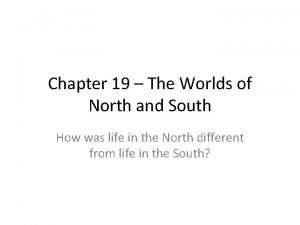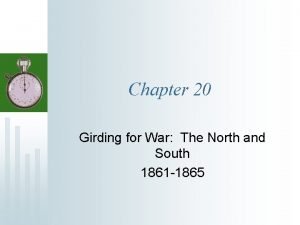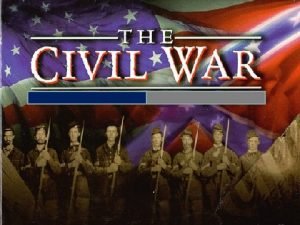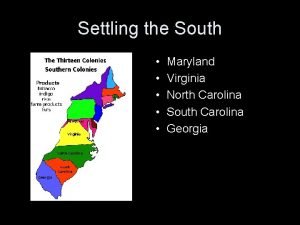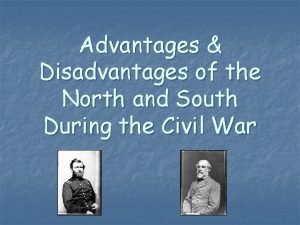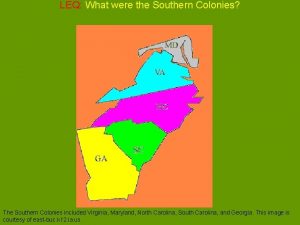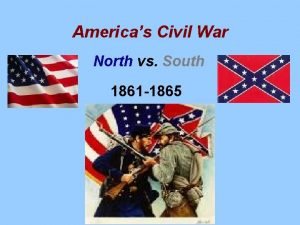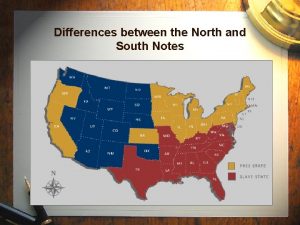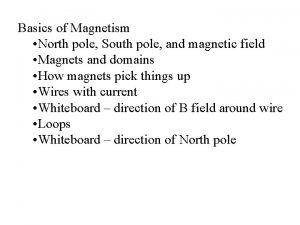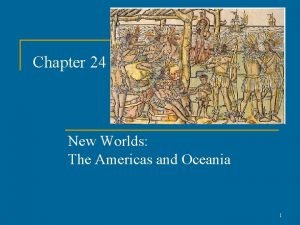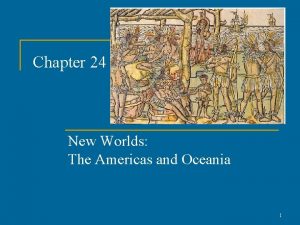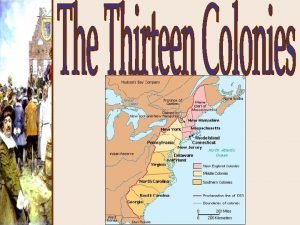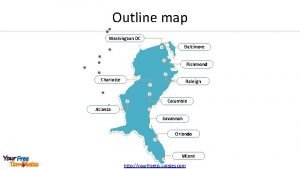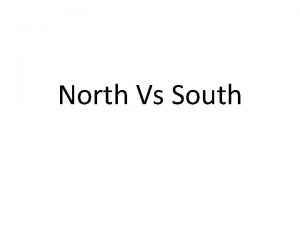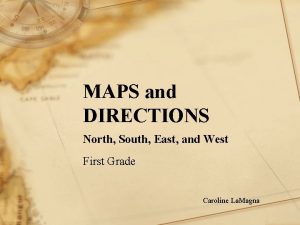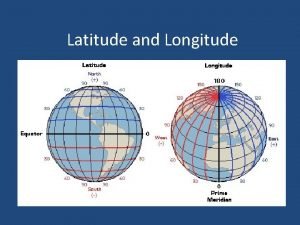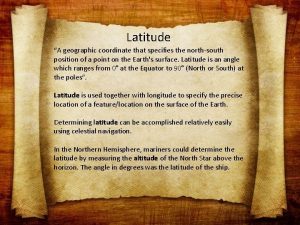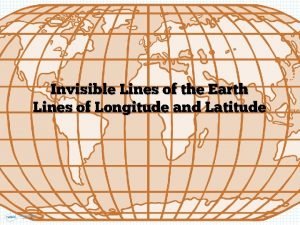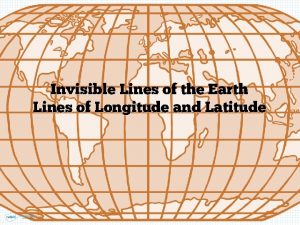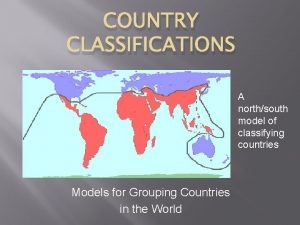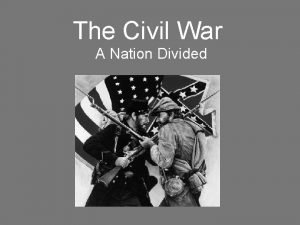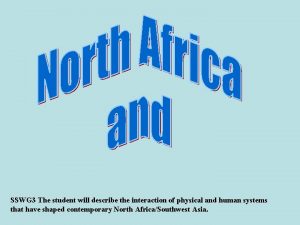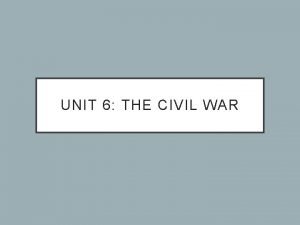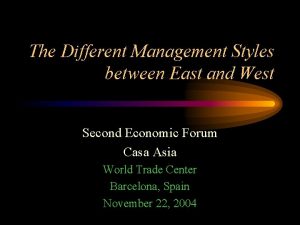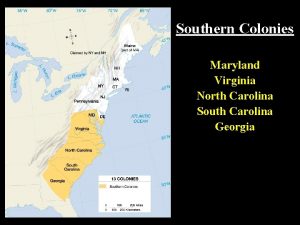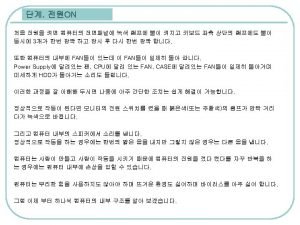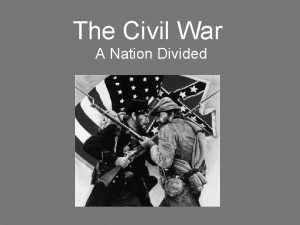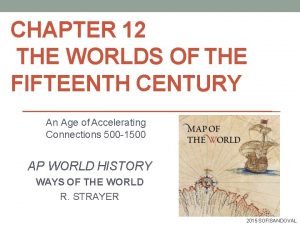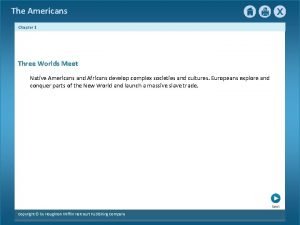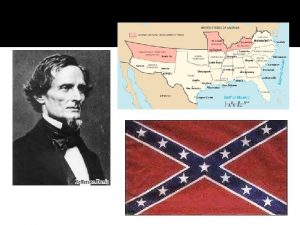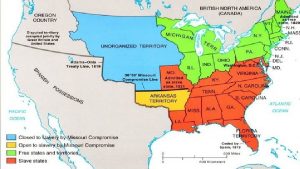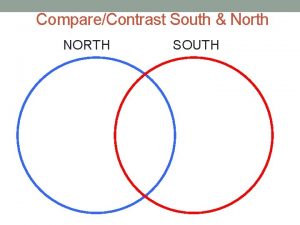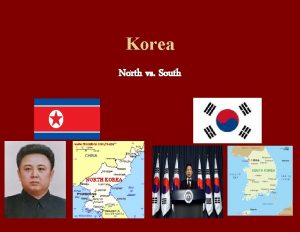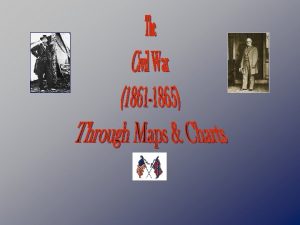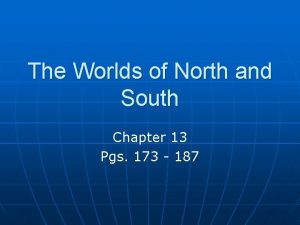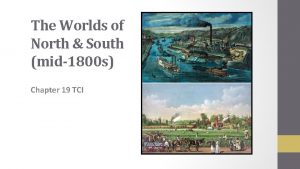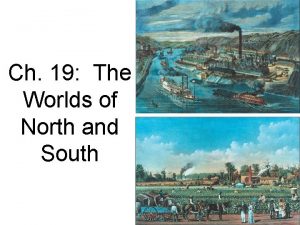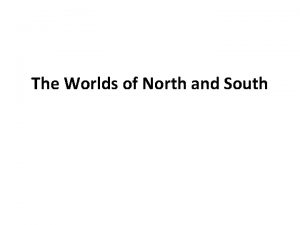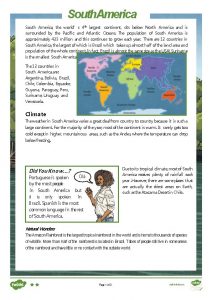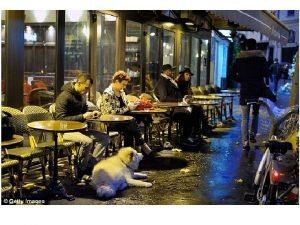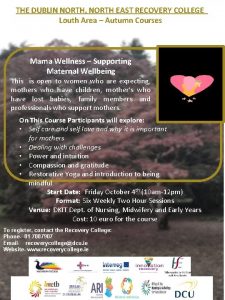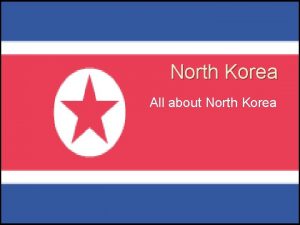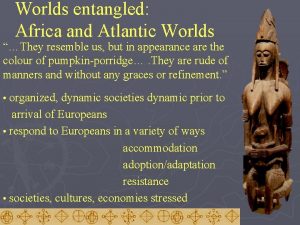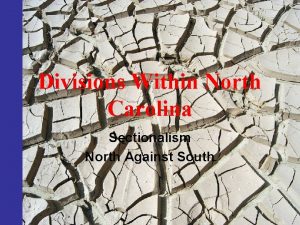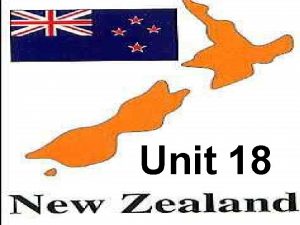Chapter 19 The Worlds of North and South









































































- Slides: 73

Chapter 19 – The Worlds of North and South How was life in the North different from life in the South?


19. 2 – Geography of the North

19. 2 – Geography of the North • Climate – 4 distinct seasons – More northern states (Maine & Minnesota) have colder winters and shorter summers than others like Pennsylvania and Ohio




• Natural Features – Northern New England (Maine) • Jagged coastline with bays and inlets (perfect harbors) • Rocky soil • Thick forests – Southern New England (Pennsylvania) & the Midwest (Michigan!) • Flat land • Rich deposits of soil


19. 5 – Economy of the North • Everything manufactured was once created by hand – Shirt, gun, carriage, etc • In the late 1700 s, inventors began creating machines that could do the work more quickly and cheaper • This was the beginning of the Industrial Revolution

• The Growth of Industry – The Industrial Revolution began in England where mill operators used machines to spin cotton into thread and weave those threads into cloth • These devices were powered using steam – The process was brought back to the U. S. and improved. • Goods could now be made cheaper and more plentiful • Less-skilled laborers could find work

– In the North, the industrial owners were creating a new source of great wealth • They favored strong national government that could make improvements to manufacturing, trade, and transportation – Southerns looked down upon this, calling the factory workers “wage slaves” – … really? • They were worried that northern interest might overpower their way of life – …well

• Machines Make Agriculture More Efficient – Inventions like the “reaper” could cut 28 times more grain than a single man with a scythe – By 1860, the value of Northern manufacturing was ten times greater than in the South

The London 2012 Olympics opening ceremony


19. 6 – Transportation in the North • John C. Calhoun (South Carolina congressman) proposed an infrastructure of roads and canals to “bind the republic together. ” • Building Better Roads – A National Road (a highway) was suggested in 1816, but James Monroe vetoed it because spending federal money on such things was unconstitutional. – Today? ? ?


• Fast Ships and Canals – River travel was faster and cheaper than travel by land. – Steam helped power ships traveling rivers – Sleeker ships were made to cross the Atlantic and Pacific Oceans in record time. – Anyone play Assassin’s Creed? ?


• Traveling by Rail – Inspired by steamships, locomotives (trains) were invented to travel across the land (wherever tracks could be laid – even across mountains). – By 1860, more than 20, 000 miles of track had been laid.

• WRAP UP QUESTIONS: – Who has the most to gain from the trains, boats, and roads? – How does the North view this? – What do you think the South thought about this?

19. 9 – Society of the North • Most people were neither wealthy nor powerful. • But they believed in the American dream – that with hard work, ordinary people could acquire wealth and influence.

• By 1860 – 7/10 northerners still lived on farms – People moved to towns and cities, tripling the population of Boston, Philidephia, and New York. – 50 of the largest cities were in the Northeast (except for Chicago and Detroit and 12 southern cities) – More than 1 million people lived in New York City

• African Americans in the North – After the American Revolution, all northern states had begun ending the practice of slavery. – While free, African Americans were not considered equals to whites: they could not vote, hold office, serve on juries, attend white churches or schools. – They started their own churches and businesses – Finding a job was hard, so they often worked as laborers or servants

• Immigrants Arrive in the North – Between 1845 -1860, 4 MILLION immigrants moved to northern parts of America • Most were from Ireland or Germany because of drought and revolution, respectively – Some came with money to buy land farms, but most found jobs in mills and factories – This created anti-immigrant feelings • Riots • Discrimination

• WRAP UP QUESTIONS: – What is your ancestry?



19. 3 – Geography of the South

• Climate – Mild winters and long, hot, humid summers – Plentiful rainfall • Perfect for growing crops! – Here come the memes!!




• Natural Features (outer parts) – Wide coastal plains on the outer edge from Chesapeake Bay and around to the Gulf Coast – Swamps and marshes



• Natural Features (interior 1) – Fertile lowlands with plains full of rich soil – perfect for raising crops




• Natural Features (interior 2) – Appalachian Mountains • Some farmers worked “on land so steep that they keep falling out of their cornfields”





19. 4 – Economy of the South • The economy of the North was able to successfully run factories – mostly because of the cooler climate made it easier to run the machines most of the year. • Based on the geography (and your own knowledge), what would be the primary economy of the pre-Civil War South? – What about today?

• Most white southerners were agrarians. – Some were small time farmers who could provide for their family and a little extra income – Some were plantation owners, who did not have to do the work of growing crops themselves – What does that compare to today?

• Plantation owners used slaves to grow cash crops such as

• The practice of slavery and slaves had begun to decline in the 1790 s – American products could be purchased cheaper from other British colonies • In addition to those, cotton was a promising crop, but the cleaning process made it not worth the effort. – Then came Eli Whitney…


• King Cotton – The cotton gin did the same work as 50 laborers • YAY! – Within 10 years, cotton sales earned more money than all other US exports • WHOOHOO!! – How do you think the North reacted to this?

• Expanding Demand for Land Slaves – However, instead of lightening the work of slaves (or ending slavery it altogether), Whitney’s invention INCREASED the demand • NOOOOOO!!!!!!!!! – Between 1790 -1850, the number of slaves rose from 500, 000 to 3 million •

– Cotton fields also wore out the soil, so they kept expanding West • Because apparently, no one listened during the Native American lecture on crop rotation… – How do you think “King Cotton” made the southerners feel? – As the Industrial Revolution began in the North, the southerners felt cotton was the best investment, and poured all of their money into slaves and land • Their thought process: “We purchase all our luxuries and necessities from the North…”

– One notable exception to all of this was the Tredegar Iron Works in Richmond, Virginia • They employed mostly slaves, but the factory produced ammunition for the U. S. army, as well as steam engines, rails, and locomotives. • While hugely beneficial, most white southerners made their living off the land. • RANDOM QUESTION: What about the location of this makes it unique? • With the impending split of the country, what predictions can you make about this factory?


19. 7 – Transportation in the South • Most rail lines were in the North – What are some reasons why they weren’t in the South?


• Because of these obstacles, southerners continued transporting people and goods via rivers. – Slow current – Broad channels – Relatively cheaper than land or building rails • Once the product (typically cotton) reached the sea, it was loaded onto ships headed for…?


• Being the primary source of transportation in the South, many cities formed on waterways – Cincinnati, OH & KY – Memphis, TN – Nashville, TN – St. Louis, MO – New Orleans, LA – Baton Rouge, LA

• Whenever federal funding for internal improvements came up (roads, railways, canals), how do you think the South responded? – Why? ? – Can you connect this to current legislation?

• Some railroads were ultimately built in the South – Southerners were proud of this because the iron rails used to build this railroad came from Virginia's Tredegar Iron Works. • By 1860, the South had 10, 000 miles of rail compared to the North’s 20, 000

19. 8 – Society of the South • President Andrew Jackson’s policies and reform movements did not make a huge impact on way of life for southerners. – Wealth = land + slaves – Social structure was: • Rich plantation owners • White farmers & workers • African Americans


• Slavery comprised every aspect of life for the South – True for both black and white – True for religion • Church officials defended the practice – Differed from the North, whose leaders taught it was un. Christian • Huck Finn example

• As long as the culture and economy was preserved, the South had little incentive to make progress economically or culturally. – “The South grew, but it did not develop. ”

• White Southerners – Wealthy plantation owners • • • Dominated the economy and politics Treasured leisure Enjoyed parties and social visits Sons went to universities Daughters rarely educated, but were instead brought up to be gracious wives and hostesses

– Most white southerners • Owned some land • Only 1 in 4 owned even one slave • Worked their own fields and made what they needed – The poor white southerners • 10% were too poor to own land • Rented mountain or forest land paid with the crops they raised

– Public schools • There were only a few, and the ones that existed were – A distance to travel – Inferior to those in the North • Because of this, many white children were illiterate

• African Americans in the South – A small group of African Americans were free • They were forced to – wear special badges – pay extra taxes – live separate from whites • Most lived in cities and worked as craftspeople, servants, or laborers

– The majority were slaves who worked as • • • Cooks Carpenters Blacksmiths House servants Nursemaids Although most were field hands who worked from dawn to dusk


END
 The worlds of north and south answer key
The worlds of north and south answer key Lesson quiz 14-1 north and south
Lesson quiz 14-1 north and south Slides
Slides Chapter 20 girding for war the north and the south
Chapter 20 girding for war the north and the south Advantages and disadvantages of the north and south
Advantages and disadvantages of the north and south Lines that run east and west but measure north and south
Lines that run east and west but measure north and south Maryland, virginia, north carolina, south carolina, georgia
Maryland, virginia, north carolina, south carolina, georgia North and south advantages and disadvantages
North and south advantages and disadvantages North and south strengths and weaknesses chart
North and south strengths and weaknesses chart Swana
Swana Angular distance north and south of the equator
Angular distance north and south of the equator North and south states civil war
North and south states civil war Map of north carolina and south carolina
Map of north carolina and south carolina Us north vs south
Us north vs south Asia europe north america
Asia europe north america North and south notes
North and south notes North, central, and south america
North, central, and south america Define north pole and south pole
Define north pole and south pole North east and cumbria ics
North east and cumbria ics New worlds the americas and oceania
New worlds the americas and oceania Chapter 24 new worlds the americas and oceania
Chapter 24 new worlds the americas and oceania Ap world history chapter 20 the americas and oceania
Ap world history chapter 20 the americas and oceania Chapter 24 the americas and oceania
Chapter 24 the americas and oceania Old south vs new south streetcar named desire
Old south vs new south streetcar named desire Virginia, maryland, north carolina, south carolina, georgia
Virginia, maryland, north carolina, south carolina, georgia Washington dc outline map
Washington dc outline map North vs the south
North vs the south Who killed reconstruction
Who killed reconstruction World map north south east west
World map north south east west Horizontal imaginary lines
Horizontal imaginary lines Coordinates that specifies the north-south position
Coordinates that specifies the north-south position Parts of the globe
Parts of the globe 50 nifty united states from 13 original colonies
50 nifty united states from 13 original colonies North south east west in our calm objective opinion
North south east west in our calm objective opinion What is the dependency theory ap human geography
What is the dependency theory ap human geography North south east west leadership styles
North south east west leadership styles Invisible line from north to south
Invisible line from north to south North south model
North south model Manmeet gill
Manmeet gill A nation divided: north vs. south
A nation divided: north vs. south North east south west
North east south west North south initiative
North south initiative North south china
North south china Reasons for civil war
Reasons for civil war North, south east west leadership styles
North, south east west leadership styles North vs south civil war
North vs south civil war Virginia, maryland, north carolina, south carolina, georgia
Virginia, maryland, north carolina, south carolina, georgia Lga pin
Lga pin North bridge south bridge
North bridge south bridge Tamassia martins
Tamassia martins North south east west globe
North south east west globe Nccr north south
Nccr north south A nation divided north vs south answer key
A nation divided north vs south answer key True north vs magnetic north
True north vs magnetic north The north pole ____ a latitude of 90 degrees north
The north pole ____ a latitude of 90 degrees north The worlds of the fifteenth century
The worlds of the fifteenth century Chapter 12 the worlds of the fifteenth century
Chapter 12 the worlds of the fifteenth century Chapter 10 the worlds of christendom notes
Chapter 10 the worlds of christendom notes Western christendom ap world history
Western christendom ap world history The worlds of christendom
The worlds of christendom Chapter 1 three worlds meet answer key
Chapter 1 three worlds meet answer key Hát kết hợp bộ gõ cơ thể
Hát kết hợp bộ gõ cơ thể Bổ thể
Bổ thể Tỉ lệ cơ thể trẻ em
Tỉ lệ cơ thể trẻ em Chó sói
Chó sói Glasgow thang điểm
Glasgow thang điểm Chúa yêu trần thế alleluia
Chúa yêu trần thế alleluia Môn thể thao bắt đầu bằng từ chạy
Môn thể thao bắt đầu bằng từ chạy Thế nào là hệ số cao nhất
Thế nào là hệ số cao nhất Các châu lục và đại dương trên thế giới
Các châu lục và đại dương trên thế giới Cong thức tính động năng
Cong thức tính động năng Trời xanh đây là của chúng ta thể thơ
Trời xanh đây là của chúng ta thể thơ Cách giải mật thư tọa độ
Cách giải mật thư tọa độ
